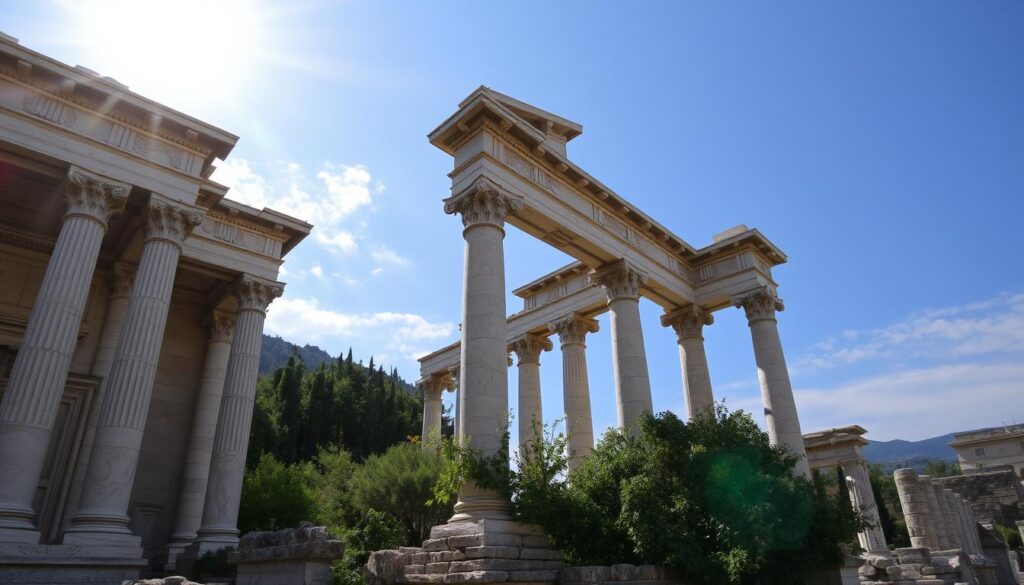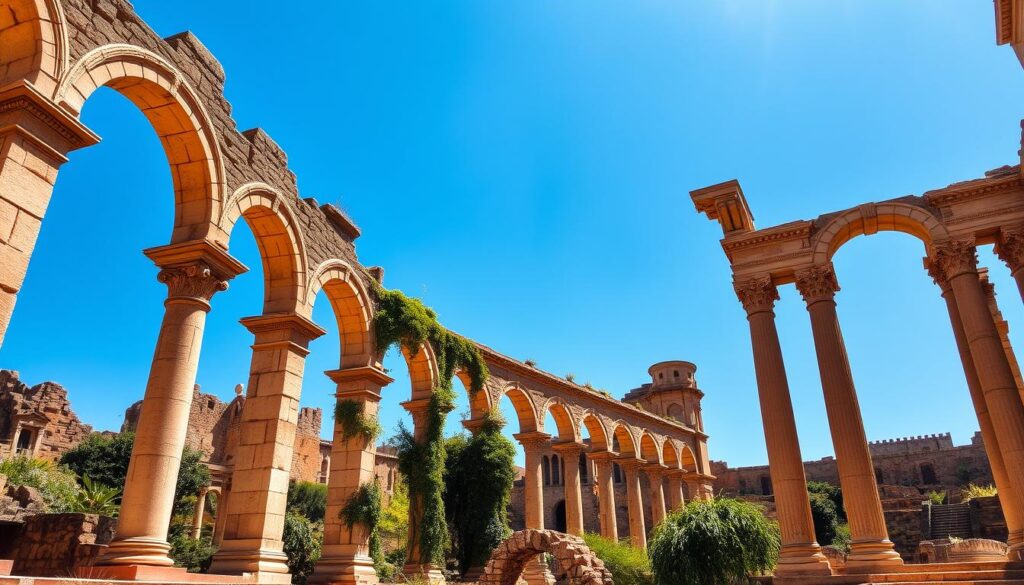The Acropolis of Athens is a UNESCO World Heritage Site. One of the world’s most renowned ancient ruins. Located on a holy hill that rises above the city, the Acropolis offers stunning views of downtown Athens and highlights such as the Parthenon.
The Parthenon The temple of Athena is an ancient Greek construction wonder. Displays the talents of the builders.
Monument
Construction Date
Significance
Parthenon
447-432 BCE
Temple dedicated to Athena, symbol of Athens
Propylaea
437-432 BCE
Monumental gateway to the Acropolis
Erechtheion
421-406 BCE
Temple honoring Athena and Poseidon
Visit the Oracle of Delphi
The Oracle of Delphi in ancient Greece was a method for humans to communicate with the gods, primarily Apollo. On the slopes of Mount Parnassus. There are temples of Apollo, theaters, and stadiums found on the site.
Delphi is a must-visit place in Greece because of its natural beauty and mythological history. It is a place where the myths happen.
“Know thyself.” Inscription at the Temple of Apollo, Delphi
Hang Out at the Ruins of Olympia
Olympia in the Peloponnese is where the games were born. An ancient stadium in which athletes contested for Zeus. The ruins of the Temple of Zeus and Temple of Hera are also visible.
The first is the recorded Olympic Games in 776 BCE.
The games were repeated once every four years (this is a convention that proceeds with the advanced Olympics).
The Olympic Truce allowed athletes to travel safely to Olympia
That the ancient ruins of Greece offer a window into Greek mythology and provide one point of departure for our own Western civilization. When you see these places, you can feel the creativity and heritage of the ancient Greeks.
The Ancient Wonders of Italy
Italy is one of the truly great countries in Western Europe, with a rich history that could fill several textual volumes. It hosts ancient ruins that transport you back to the heights of the Roman Empire. As you weave through the streets, you will discover countless amazing archaeological treasures that really emphasize the talent and worldliness of Roman construction.
Go Back to the Past at the Colosseum
Rome, Italy— A trip to Italy would be incomplete without seeing the Colosseum in Rome. It has now become one of the seven wonders. Constructed to stage gladiatorial fights and public spectacles, nowadays it hosts over 7 million people annually who come to experience the thrill of yesteryear.
Discover the Hidden Mysteries in Pompeii
Frozen in time, quite literally at the foot of Mt. Vesuvius when it blew her top in 79 AD, the city that was Pompeii. It is an open-air museum, with its streets and buildings giving a view into life in the ancient Roman city. You will get to see amazing mosaics and frescos that represent the art, experience, culture, and daily life of the town.
Find Out for Yourself the Real Roman Eternal City
Rome is inundated with ancient Roman architecture. Bits of the greatness of the empire can be found everywhere. The heart of the old Roman Forum, where you can walk through as they did emperors and orators. The huge dome of the Pantheon demonstrates the Roman engineering prowess. There are also several ancient sculptures and artifacts in the Vatican Museums, in which it is possible to know something of Rome’s history.
Attraction
Annual Visitors
Colosseum, Rome
Over 7 million
Uffizi Gallery, Florence
Around 2 million
Venice
Approximately 20 million
This is why covering Italy’s ancient wonders helps you to explore what remains behind the history of the Roman Empire. Italy’s treasures, from the Colosseum to Pompeii’s ruins, offer a window into the past. They are inviting you to come and discover the secrets of Rome’s ancient past and experience its spirit.
Exploring Ancient Ruins in Europe
Think of this as the beginning of an epic voyage into the ancient history of Europe. Unearth lost treasures and uncovered the paths of mighty ancient civilizations. From the megalithic temples of Malta to the prehistoric cave paintings in Spain.
Discover the ancient castles like Dunluce Castle in Northern Ireland. A castle again, built on a rock, dates from the 13th century. Like the 2,000-year-old fortress of Klis in Croatia. Take guided tours to get acquainted with the ancient population of Europe.
Malta’s Megalithic Temples: Be Amazed at the Skills of Ancient Builders The oldest of these monuments, such as the Ġgantija temples on Gozo, date back over 3,600 years. It reveals the amazing architecture of our forefathers.
“Visiting the ancient ruins of Europe is a bit like traveling in a time machine that takes you back to explore worlds filled with wonder and mystery.” – Sarah Thompson, archaeologist and tour guide.
Visit ancient caves in Europe to see prehistoric art. (Altamira Cave, Spain) 35,000 years of cave paintings offer a glimpse into the lives of our ancient relatives.
Ancient Ruin
Location
Age
Stonehenge
United Kingdom
Constructed between 3,000 and 2,000 BC
Colosseum
Rome, Italy
Completed in 80 AD, nearly 2,000 years old
Acropolis
Athens, Greece
Built between 447 and 438 BC
Newgrange
Ireland
Built around 3,200 BC
The classical debris in Europe reminds us of the means and methods our ancestors used. From the temples of Malta to the cave paintings of Spain, these are places that connect us with a repudiated past. They are a voice to our own Shakespearean tales that have influenced the earth.
United Kingdom: Enigmatic Stonehenge and Beyond
Home to some of the greatest ruins in Europe, the United Kingdom is brimming with the remnants of times gone by. Meaning there are sites here like Stonehenge and all that stone-circle malarky. They allow us to get in touch with our ancient ancestors.
When you look at the prehistoric sites of the UK, there are lots of stone circles. And similarly, one mystery and story of its own. Here you see the creativity and beliefs of past generations reflected against a backdrop of beautiful scenery.
Reflecting on the purpose of Stonehenge
Salisbury Plain is in Wiltshire, and this is the famous Stonehenge. It was erected between 3000 and 1000 B.C. and has baffled people for centuries. Though it is unknown their true usage, some believe the site to be a burial ground and others an astronomical calendar.
Stand in the ruins at Stonehenge and marvel at how these massive stones have been moved and placed. A strange part of the monument is that it has stones that coordinate with the sun solstice, which is part of its legends.
Stonehenge Facts
Details
Construction Period
3000 – 1000 BC
First Stones Raised
2400 – 2200 BC
Circular Earth Bank and Ditch
circa 3100 BC
UNESCO World Heritage Site
Since 1986
Ownership
The Crown (managed by English Heritage)
Unlocking the Secrets of Avebury
Avebury—20 miles north of Stonehenge—is another must on the itinerary. Europe’s largest stone circle was built around 2600 BC. It includes three concentric rings, a henge, and avenues of standing stones.
As you walk among the stones when you visit, they will strike you for sure regarding their size and also how much effort it would take to put them up in place. To this day, the function of Avebury remains enigmatic, but from the evidence it appears to have been a ceremonial site.
“We shall not cease from exploration, and the end of all our exploring will be to arrive where we started and know the place for the first time.” – T.S. Eliot
The UK is home to many more prehistoric sites and stone circles. From the Ring of Brodgar in Orkney to the Callanish Stones in the Outer Hebrides, each one offers a different view into our ancient past.
As you wander around these ancient wonders, be sure to take a moment to appreciate the creativity and faith of our forebears. Wander these stones either at Stonehenge or Avebury, and you will be amazed by their beauty and, above all, the feeling of belonging to history.
Turkey: Where East Meets West
Turkey—where Europe meets Asia. It takes you on a timeloop like no other. The ancient civilizations you can find here range from the Ottoman Empire to even more ancient times in the Byzantine era. Turkey is a virtual open-air museum, with well-preserved cities, buildings, libraries, and museums from the Hittites to early Christian monarchies. predpredgettene live in their culture.

Immerse Yourself in the Grandeur of Ephesus
The Ancient City of Ephesus It dates from around 10 BC and flourished under the Romans. Today a UNESCO World Heritage Site, it is visited by over 2 million people annually.
Wander the streets of Ephesus, including the Library of Celsus. Having been known for most of its history as one of the largest libraries in the ancient world, it contained an estimated 12,000 scrolls. Do not miss the Temple of Hadrian and the Great Theater either. The theater, an indication of the grandeur of Ephesus, could seat 25,000 people.
Ephesus—Fun Fact: Ephesus, at its peak, a quarter of a million people strong, was the largest city in the Roman Empire.
Explore the Underground Cities of Cappadocia
Cappadocia, which has underground cities of early Christians, is another wonder. They are basically engineering marvels. On the surface, you have fairy chimneys and cave dwellings. Cappadocia Earning its place as one of Turkey’s most famous regions, Cappadocia attracts 2 million visitors a year, many coming for the hot air balloon experience.
Popular Attractions in Turkey
Approximate Visit Duration
Blue Mosque
30 minutes
Hagia Sophia
1 hour
Topkapi Palace
2 hours
Ephesus
3 hours
Cappadocia
2-3 days
Archeology museums — a must-see for information on the history of Turkey in Istanbul They also exhibit artifacts from the time of the Ottomans and Byzantium. What we see here is an immense history that is waiting to be explored, so in short, Turkey has more places that are historical treasures.
From Prehistoric Caves to Roman Amphitheaters in France
Embark on an Intrepid Adventure Through France’s Ancient Ruins You will come across a wealth of ancient marvels. There are plenty of archaeological wonders in France, from the Lascaux cave paintings to the Roman amphitheaters.
Lascaux Caves (I recommend you go here first), There are incredible prehistoric cave paintings here, which date back to over 17,000 years. The hunting scenes in these paintings depict both animals and humans, which offers a glimpse into the lives of early men.
Then make your way to the Carnac Stones in Brittany. This is one of the largest megalithic complex in the world. These ancient standing stones just go on and on in every direction, leaving one to ponder what purpose they served.
Site
Location
Period
Lascaux Caves
Dordogne
Paleolithic
Carnac Stones
Brittany
Neolithic
Nîmes Arena
Nîmes
Roman
Pont du Gard
Vers-Pont-du-Gard
Roman
And then make your way down south to Nîmes Arena, France. One of the ways it remains a modern-day amphitheater, in fact, concerts still take place here today. The former site of gladiatorial games, it is a testament to the architectural prowess of the Romans.
The Pont du Gard, a UNESCO World Heritage Site, bears testament to the Roman engineering ingenuity. One of the finest Roman structures in Europe, this aqueduct (built over 2000 years ago) used to convey water from the mountains near Segovia.
Throughout France, the ruins left by the Gallo-Romans are very evident. For instance, the Thermes de Cluny in Paris and the Arènes de Lutèce amphitheater. But it sort of gives us a view into the past.
France museums are also having a lot of information on it. Objects in various eras will be on display by the Musée de Cluny in Paris and the Musee d’Archeologie Nationale in Saint-Germain-en-Laye.
France even features ancient ruins that bring important heritage for them to be an unmissable excitement. Our ancestors were a pretty ingenious and artistic bunch, as you will see in everything from cave paintings to Roman amphitheaters.
Roman Castle in Palma, Spain
While traveling through Spain, be prepared to be amazed by the Roman Empire everywhere. Spain fell under Roman rule for close to 700 years, and so they have many impressive structures on offer. And even today, many visitors come to this marvel of wonders.

Some ancient ruins of Spain depict advanced Roman engineering and design. By considering these sites, you will get to know more about the rich history and culture of Spain.
Visit the Segovia Avenue
Another fine sample of Roman architecture, the Aqueduct of Segovia, is a highlight in Spain. An engineering marvel built in the 1st century AD. It transports water more than 800 meters from the Frío River to Segovia.
The high arches and intricate stonework of an aqueduct are magnificent to behold. It displayed the Romans mastery of engineering without the modern-day tools, obviously. If you are keen on Roman architecture, then the Aqueduct of Segovia is for you.
Admire the Roman Theatre of Mérida
Also worth mentioning is the Roman Theatre of Mérida. Constructed in the 1st century BC, it would seat up to 6,000 people. Breathtaking: it has an imposing stage with columns and even statues in the front.
From the ancient seats, you could almost hear past performances. The Roman Theatre of Mérida represents the Roman culture present in Spain until today.
Roman Site
Location
Highlights
Itálica
Andalusia
Birthplace of emperors Hadrian and Trajan
Las Médulas
León
Vast ancient Roman gold mining site
Tarraco
Tarragona
Capital of Hispania Citerior, impressive circus and amphitheater
Empúries
Catalonia
Originally Greek, later conquered by Romans
Temple of Diana
Mérida
First-century temple with iconic hexastyle portico
When visiting Spain’s ancient ruins, look for the influence of later cultures, such as the Moors. We will explore sites that tell the story of Spain’s sometimes violent past, with stops at the Alhambra in Granada and the Mosque-Cathedral of Córdoba, among others..
“I found Rome a city of bricks and left it a city of marble.” – Augustus Caesar
There is no shortage of Roman architecture and archaeological parks in Spain. It bids you to explore the heritage of the Adroit Romans. So, pack your bags soon and experience the amazing talent and artistry by looking at the ancient ruins within Spain.
Croatia: Diocletian’s Palace and Beyond
The Dalmatian coast, where old history meets modern charm, is a fascinating area to wander. Croatia—Rotting ruins of an old world One of the main places to see there is Diocletian’s Palace in Split.
Travel back in time to Diocletian’s Palace
Diocletian Palace (built over 1700 years ago) Constructed for the Emperor Diocletian in the early 4th century A.D. As such, as you walk around, Roman and medieval architecture is still visible to this day.
The heart of the palace is the Peristil Square. Discover the hidden stories below the ancient cellars. Visit the Cathedral of St. Domnius to walk through the Golden Gate you need for protection.
Attraction
Highlight
Peristil Square
The center of Diocletian’s Palace
Palace Basements
Ancient cellars filled with history
Cathedral of St. Domnius
A symbol of Split’s enduring history
Golden Gate
The main entrance to Diocletian’s Palace
Visit the Ancient Salona
Near Split, Salona was the Roman capital of Dalmatia. Discover Roman times at the amphitheater and necropolis..
The left big toe of Gregory of Nin’s monument in Split is rubbed to bring good luck widespread among Croatians.
Croatia has some of the best ruins you can walk through. And the influence of the nearby Adriatic Sea gives it more appeal.
Conclusion
Ancient ruins in Europe offer a taste of the rich history of the continent. Greece, the cradle of Western civilization, and the expansive Roman Empire These sites reveal an innovative and industrious side to historical people.
See Europe; across the continent you will find the Acropolis in Athens or the Colosseum in Rome. In the UK, you’ll head across to Stonehenge, one of the most famous and enigmatic sites in the world. All of them depict the unique story of how their creators showcased their skills and beliefs.
It’s not just a journey to visit the ancient ruins of Europe. It is an opportunity to discover our world now. These old civilizations are responsible for a lot of what we acknowledge as modern ideas and practices. The way we speak and the buildings around us are inspired by the Islamic Golden Age and the Roman Empire.
Therefore, consider visiting the original remains of Europe in your next tour. Such sites are not only aesthetically pleasing, but they also help keep a metaphorical umbilical cord to what our ancestors went through. They do this for an unforgettable and significant trip.
FAQWhich ancient Greek ruins should everyone see?
Greece has a lot of old walls and stuff. View the Acropolis of Athens and Oracle at Delphi. Be sure to check out the city of Olympia and go to the ruins, and also see the Temple of Poseidon in Cape Sounion. These places represent the origins of Western civilization and ancient Greece.
Can I explore the ruins of Pompeii in Italy?
You can now take a trip to Italy to visit the historic site of Pompeii. It truly feels like entering a time warp. The city was preserved thanks to the eruption of Mount Vesuvius in 79 AD. You can take a look at the way ancient Romans lived.
Why is Stonehenge important in the United Kingdom?
Stonehenge is a mysterious stone circle in England. It’s over 4,000 years old. You will probably wonder why the hell it was built still. It even shows its astonishing design of how the stars are placed.
Are there any impressive Roman ruins in France?
France has many Roman ruins. L: Pont du Gard water bridge, R: Nimes ancient amphitheatre Here are some of them; they reflect the Romans’ mastery in building and how their lasting relics remain littered around France.
What ancient ruins can I visit in Spain?
Spain has many ancient ruins, especially from the Romans. You should see the Aqueduct of Segovia and the Roman Theatre of Mérida. Also, visit the archaeological park of Italica near Seville. Spain’s ruins also show the influence of the Moors, like the Alhambra in Granada.
Are there any ancient ruins worth visiting in Croatia?
Croatia, yes, you have Diocletian’s Palace in Split (UNESCO site). Originally, the palace was built for Roman Emperor Diocletian in the 4th century AD. Furthermore, you can visit the ancient Dalmatian capital of Salona.
What are some lesser-known ancient ruins in Europe?
There are countless ancient ruins yet to be discovered in Europe. There are megalithic temples in Malta, for example. Altamira´s cave paintings (Spain), Ancient fortresses in Northern Ireland and Croatia, Neolithic settlement in Scotland is called Skara Brae.
Are there guided tours to ancient Europe’s ruins?
Certainly, the original remains at most ancient ruins will have guided tours. They are led by experts on tours. They are giving you a detailed glimpse of the past and the culture of these places. It is something that makes one appreciate the great past of Europe an awful lot more.
Source link : http://www.bing.com/news/apiclick.aspx?ref=FexRss&aid=&tid=66fbb8daf0734614928d393f0aee4065&url=https%3A%2F%2Flive-pr.com%2Fdiscover-ancient-ruins-in-europe-your-adventure%2F&c=16236386201519594766&mkt=de-de
Author :
Publish date : 2024-09-30 17:00:00
Copyright for syndicated content belongs to the linked Source.


